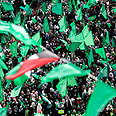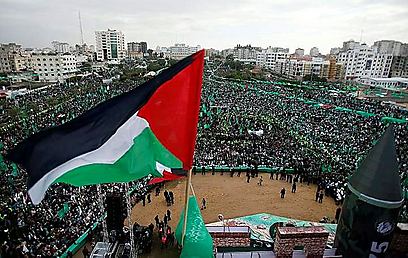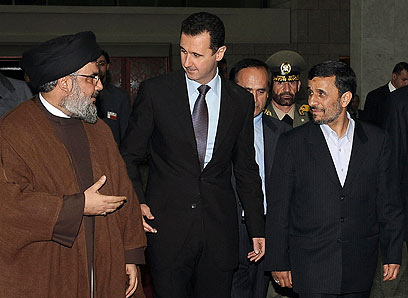
A refugee from Syria recently opened a bakery here, drawing long lines of customers eager to taste meat and cheese pastries with the special flavors of Damascus - a rare bright spot in the long shadow that the Syrian civil war is casting over the Gaza Strip.
The conflict in Syria, some 300 kilometers (190 miles) away, is increasingly hurting Hamas-ruled Gaza financially, according to several figures in the Islamic terrorist group and in Islamic charities.
Related Stories:
- Tear between Hezbollah, Hamas: 'Leave Lebanon'
- Hamas training Syrian rebels in Damascus
- Syrian guerrilla fighters being sent to Iran for training
They say Iran, an ally of Syrian President Bashar Assad and a former major financial backer of Hamas, has reduced monthly cash transfers because Hamas refuses to side with the Syrian regime.
Islamic charities abroad that used to donate heavily to Gaza have been redirecting some of their aid to Syria, forcing local charities to scale back programs, aid officials said.
"All of Gaza is suffering from this," said Noha Zaki of Gaza City's Amal orphanage, home to 100 children. Zaki said donations to her charity are down by 50%.
In a further costly twist, more than 1,500 people fleeing the fighting in Syria, most with family ties to Gaza, have arrived in the coastal territory since last year, with hundreds more en route.
Bassel Shunar, co-owner of the new bakery - "Damashki" or "The Guy From Damascus" - had a soft landing. But aid officials say they have trouble finding jobs and homes for other newcomers in crowded, impoverished Gaza.
The Hamas finance minister, Ziad Zaza, acknowledged government money problems but blamed long-running Israeli restrictions at Gaza's borders. He denied his government receives money from Iran and claimed donations from abroad are still in the normal range of $5 million to $12 million a month.
Since its founding in 1987, Hamas has operated an aboveground political wing and a secret military wing. The Sunni Muslim movement is secretive about its finances. It has released only partial information about the spending of the Gaza government it formed after overrunning the territory in 2007.
After the popular uprising against Assad erupted in March 2011, Hamas quickly felt the reverberations.
Hamas leaders in exile, including chief Khaled Mashaal, were based in Damascus then, but became increasingly uncomfortable with Assad's crackdown on Syria's majority Sunnis. Assad and key members of his regime are Alawites, or followers of an offshoot of Shiite Islam.
Assad, a longtime Hamas patron, demanded that the group show support for his regime. Instead, Mashaal and others left Damascus in early 2012. Mashaal moved to Qatar, part of the Saudi-led Gulf Arab bloc that opposes efforts by Shiite Iran to expand its influence.
Iran wasn't happy. But it didn't cut ties with Hamas, which is a key to Iran's regional ambitions, including setting up armed bridgeheads on Israel's borders.
As recently as November, after a bout of Israel-Gaza fighting, Mashaal thanked Iran for its support. Hamas hard-liner Mahmoud Zahar at that time challenged Gulf States to "compete with Iran in giving us weapons and money. "
Iran has reduced Gaza funding in recent months, according to an Arab diplomat and three senior Hamas figures, who spoke on condition of anonymity because they were not authorized to brief reporters on the issue.
Their estimates of Iranian cash transfers before the cutbacks ranged from $120 million to $370 million a year.
A Hamas member who provided the lower estimate said Iran has scaled back payments by 60%. The Arab diplomat said Iran still finances the Hamas military wing, but also increased funding for Islamic Jihad , a smaller group that occasionally fires rockets from Gaza, challenging Hamas' informal truce with Israel.
Zaza, the Gaza finance minister, blamed current money woes on Israel's border restrictions, which were at their tightest after the 2007 Hamas takeover of the territory, but have eased in recent years.
Zaza said spending cuts began two years ago, affecting every ministry, but did not explain why it became necessary at that time since the Israeli border blockade was in place well before then.
As part of the belt-tightening, ministries were ordered to slash operating costs by 50%, including cutting back on stationery, travel and gas allowances.
Hamas is still able to cover the government payroll - 41,000 civil servants and members of the security forces and 10,800 participants in a job-creation program.
The wage bill alone is $37 million a month, in addition to $4 million in other operating costs, post-cutbacks, compared with local monthly revenues of $18 million, according to Zaza. He did not say how the deficit is being covered.
Meanwhile, Osama Kurd, coordinator of some 200 Islamic charities in Gaza, said there has been a sharp drop in donations from abroad because more aid is going to Syria. He would not give the annual amount in donations.
Abdel Qader al-Attar of the Islamic Charity, the largest such group in Gaza, said foreign support has decreased by more than 30%.
"The Syria crisis has affected aid to the poor in Gaza," he said. "Our donors in the Gulf and in Europe told me clearly they have shifted part of their aid to Syria."
The charity has reduced financial aid to thousands of students by 40%, cut back on food distributions to 14,000 families and lowered payments for needy patients, al-Attar said.
The shift is apparent in the Arab world. In Kuwait, charities operate trailers near supermarkets. Billboards on the trailers used to appeal for help for Gaza but now have switched to Syria.
Nael Assad of the Kuwait-based International Islamic Charity Organization said donations to Gaza have dropped, and that most of the aid goes to Syria. He did not provide figures. The main Turkish charity, IHH, said it hasn't cut back in Gaza.
Gaza's money troubles come at a time when the main UN agency aiding Palestinian refugees and their descendants - a majority of Gaza's 1.7 million people - is also scaling back some services due to a long-running budget crisis.
The Palestinian refugee problem goes back to the 1948 war over Israel's creation, during which hundreds of thousands of Palestinians fled or were driven out. Those refugees and their descendants now number about 5 million people scattered across the Middle East, including in Syria, where some are displaced again.
More than 1.6 million Syrians have fled to neighboring countries since 2011.
Among those, more than 1,500 - most of them of Palestinian origin, but also a few dozen Syrians - have sought refuge in Gaza, and hundreds more are en route, said Mazin Abu Zaid of the Palestine Liberation Organization.
Shunar, the bakery owner, arrived 2 1/2 months ago with his Gaza-born wife. Shunar grew up in the Yarmouk refugee camp near Damascus and said he earned a good living with a home-decorating business.
The 45-year-old said he would like to return to Syria, despite the thriving business he recently opened in Gaza, using most of his savings.
Hassan Awad, 43, an English teacher from the Syrian coastal town of Latakia, also dreams of going back to Syria. Awad, his wife and three children were taken in by his Gaza relatives six months ago, and he has found temporary work as a translator.
It's hard to get used to cramped quarters in Gaza City's Sheik Radwan neighborhood, he said. But given the violence, a return to his hometown is unlikely.
"It's very crowded in Gaza, but what shall we do?" he said.
- Receive Ynetnews updates
directly to your desktop

















